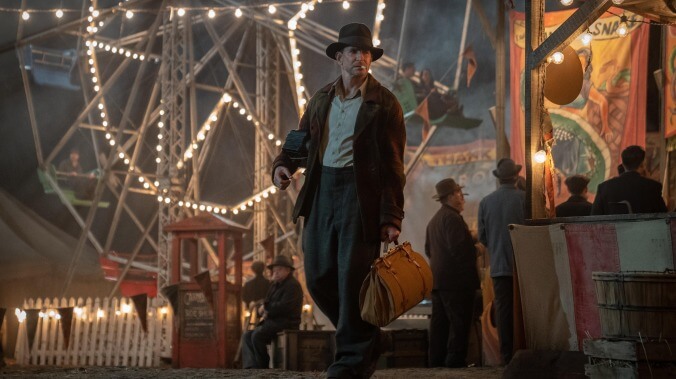Believe it or not, the sideshow is the least compelling part of Guillermo del Toro’s Nightmare Alley
Bradley Cooper, Cate Blanchett, and Rooney Mara star in this stylish but uneven carnival noir

Guillermo del Toro was born to make a carnival movie. The Oscar-winning writer-director has spent his career conjuring sympathetic monsters and romantic freaks. (He also modeled his home after a European cabinet of curiosities, a more sophisticated continental cousin to the American sideshow.) So when del Toro announced that he would be tackling William Lindsay Gresham’s 1946 novel Nightmare Alley—previously adapted into a 1947 film with Tyrone Power and Joan Blondell, but we’ll get to that in a minute—it seemed like a perfect fit. So how is an extended opening sequence set at a dusty Midwestern carnival the least compelling segment of the movie?
Because, alas, production design isn’t everything, though in a del Toro film, the textures and colors are enough to carry a viewer most of the way. When mysterious loner Stanton Carlisle (Bradley Cooper) wanders into a geek show run by the gregarious Clem Hoately (Willem Dafoe), he enters a beautifully rendered alternate universe dominated by shades of red and yellow—the colors of a traditional sideshow banner. The attractions have an intriguingly moralistic bent: There’s an astonishingly designed haunted house, for example, with a seven deadly sins theme. The geek himself, a desperate alcoholic who bites the heads off of chickens in exchange for booze, is portrayed here as a skittering creature reminiscent of Lord Of The Rings’ Gollum. This being a del Toro picture, we of course pity him.
The rest of the sideshow’s denizens are less memorable. Casting Toni Collette as Zeena, the kindly psychic who teaches Stanton the mediumship racket, would seem to be a slam dunk, as would securing Ron Perlman and David Strathairn as fellow carnies. But almost all of the impressive cast—which also includes Rooney Mara, Richard Jenkins, Holt McCallany, and Mary Steenburgen in key roles of varying sizes—seems tied down by the odd, muted tone. The only one who slips into the noir idiom like a pair of silk stockings is Cate Blanchett, perfectly cast as conniving, seductive psychiatrist Lilith Ritter. The film doesn’t really get going until Blanchett slinks in midway through, challenging Stanton’s supposed ability to read minds after he and “Electro-Girl” Molly (Mara) level up from traveling circuses to swanky nightclubs.
Blanchett’s presence also seems to awaken something in Cooper, who up to this point has conveyed little of the inner torment and grasping ambition that supposedly drive his character. It may be unfair to compare this Nightmare Alley to the ’47 version, given that del Toro has said he and co-writer Kim Morgan based their adaptation on the novel, not that movie. But the films have very similar plots, and examining two actors playing the same character is fair game. In this area, it’s a win for the earlier adaptation: Power conveys the sense that Stanton is being eaten from the inside long before he succumbs to the bottle; Cooper saves his angst and pathos for the very end of the film.
A satisfying middle section delves into the machinations of Stanton’s latest and most ambitious grift, one of those “spook shows” Zeena warned him about. (It’s too risky to claim to communicate with the dead; it inevitably gets messy.) Here, the aesthetics shift into sweeping Art Deco arches and expensive polished wood; Jenkins’ character, a sinister business tycoon of untold wealth, lives in a mansion that looks like a Depression-era post office. Del Toro performs some especially sumptuous tricks with smoke and lighting in these later, more conventionally noir-ish scenes, illuminating Blanchett and Cooper’s faces with the warm orange glow of a cigarette lighter as they trade barbs.
The heat between the two is palpable, but the larger symbolism of this cat-and-mouse game between a psychic and a psychiatrist gets lost amidst the luxurious settings and sexual tension. At the time when Gresham’s novel was first published, going to therapy was an activity that was still viewed with a sideways eye by most everyday Americans. And there’s a rich thematic thread of the similarities between religion, psychiatry, and carnival hustles that runs through the ’47 version of Nightmare Alley. Without the implication that Lilith and Stanton are essentially on the same hustle, certain plot developments later in this film no longer make much sense.
That’s typical of the movie as a whole. Nightmare Alley over-explains some of its sleight-of-hand tricks, and loses track of others over the course of its unhurried 150 minutes. Film noir is a cynical genre, and the script makes gestures toward establishing that these characters live in a cold world where nothing matters but the almighty dollar. But del Toro is a romantic at heart, and can’t help swooning where the subtext wants to spit. His sensibility isn’t a bad thing. It just works better when the monsters aren’t human.